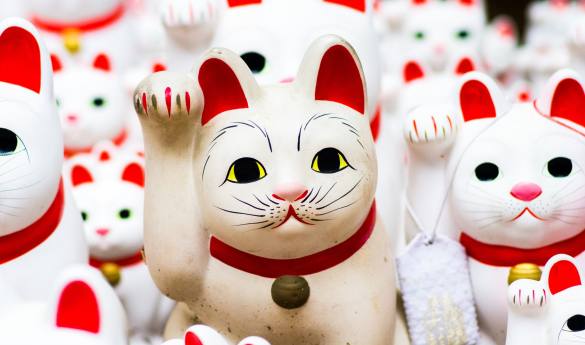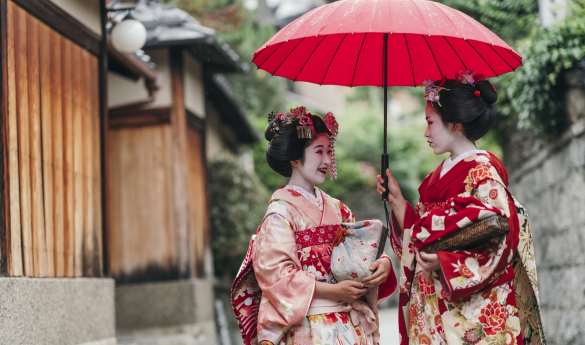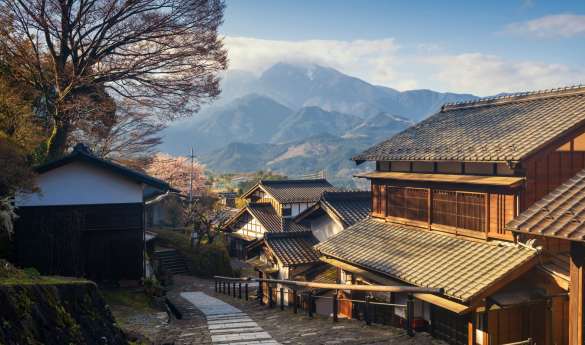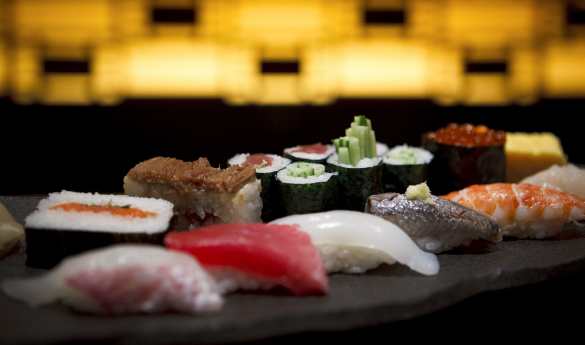5 Bucket List-Worthy Torii Gates to Visit in Japan
14 March 2023

Not only are the iconic torii gates in Japan visually stunning but visiting one provides beautiful insight into the country’s spiritual world. Found floating in lakes, in rows of thousands, and surrounded by towering forests, they are some of the most recognised and spectacular sites in Japan. If you are interested in Japan’s spirituality, history, or architecture, seeing a torii gate should not be missed.
What Are the Japanese Torii Gates?
Torii gates are found at the entrance to Shinto shrines. Thought to be the home of Shinto gods, they symbolise the transition from the human world into a sacred space, acting as the gateway between the two. Identified by their distinctive colour, the gates are painted bright red to represent vitality and protect against evil. While they were originally once white (to signify purity), when Buddhism arrived in Japan in the 6th century, shrines started to paint their gates red, which is now seen as a coming together of the Shinto and Buddhist religions. Today, you will still find smaller versions of Japanese torii gates at the entrance to shrines in Buddhist temples.
Because of the strong ties between Shinto shrines and the Japanese imperial family, a torii also stands in front of the tomb of each emperor. And you will often find them among Japan’s outstanding nature, at the base of a mountain or along the coastline, for example. These torii gates are said to embody the gods that exist in nature, a strong belief that is part of Japanese animism.
What Do the Torii Gates Represent?
The main function of Japanese torii gates is to mark sacred grounds. They embody the boundary between the human world and the holy one. Once you walk through the gate, you have entered a divine space. It is customary to bow before passing through, to walk slightly to the left or right of the centre, and not to enter until you are in a state of purity. You will often find sources of water nearby to rinse your hands and face before walking through.
The Different Types of Torii Gates
While torii gates mostly look similar to one another, there are some slight differences in their characteristics, these include:
- Whether the posts (hashira) are vertical or slightly at an angle
- Whether the top lintels (kasagi) are straight or curved
- Whether the tie beams (nuki), which are usually held in place by wedges, protrude over the posts or not
- Whether the lintels have a connecting strut (gakuzuka), these are often covered by a tablet with the name of the shrine on it
There are two main types of torii gates in Japan, the Shinmei and Myōjin.
Shinmei
The simplest and thought to be the oldest type of torii is the Shinmei, which is characterised by straight lintels sitting across the top of two upright posts. One of the most famous examples of a Shinmei torii gate is the unassuming but beautiful wooden one found at the entrance to the Inner and Outer Ise Shrines in Ise-Shima National Park. The Shinto shrines here are considered the most sacred in Japan and the nation’s spiritual home.
Myōjin
The Myōjin torii gates are the most common style in Japan. They are characterised by curved upper lintels pointing upwards and their posts are slightly inclined, as well as having gakuzuka connecting the lintels. The torii gate at the entrance to Itsukushima Shrine on Miyajima is one of the most iconic examples of a Myōjin torii. When the tide is high, it appears to be floating on water.
Different Torii Gate Colours
Torii gates now tend to be mostly red, however, you will still see some white gates, as well as plain wooden ones, and there are even some which are pink, blue, or yellow. The torii gates colour is based on the direction the shrine faces. If the shrine stands in the north, the torii gate will be black, in the east it is blue, and in the centre it is yellow. The pink torii gate (which is more unusual) is in Higashimokoto Shibazakura Park, Hokkaido. It was painted for decorative reasons, to match the pink carpet of flowers that it stands across, which bloom from May to June.
Best Torii Gates to Visit in Japan
There are about 90,000 Shinto shrines in Japan, and each has a torii gate, so narrowing down which are the five best is no easy feat. Luckily, our travel experts have done it for you.
Fushimi Inari-Taisha, Kyoto

Located in southern Kyoto and dedicated to the Shinto god of rice, Inari, the hillside shrine of Fushimi Inari-Taisha is one of the most famous torii gates in Kyoto, Japan. The iconic shrine is recognised for the 10,000 red torii gates that cascade down the lower slopes of Mount Inari, over a four-kilometre trail. The gates form a striking tunnel through the surrounding forest and walking along the trail is very atmospheric. The Yotsutsuji intersection, about halfway up, also provides beautiful views over the city.
Best time to visit: Go very early (from 6:30 am) to avoid the crowds, which start to pack in from 9 am. The early afternoon is also a beautiful time to visit because of the light, particularly in late spring and early summer (April to June).
Itsukushima Shrine, Miyajima

Miyajima Island is home to the UNESCO-listed Itsukushima Shrine, dedicated to the gods of seas and storms. The shrine is best known for its impressive torii gate, which was originally built in 593 CE and is located 200 metres from the shore. During high tide, the gate appears to float in the sea and reflects beautifully in the water. The combination of the deep blue sea and the bright vermilion torii gate creates an astonishingly beautiful scene. A kayak tour from the mainland to Miyajima Island offers incredible views of it.
Best time to visit: High tide is our favourite time of day to visit as it presents some wonderful photo opportunities, but there are advantages to visiting at low tide too as the shrine can be reached on foot.
Meiji Shrine, Tokyo

Dedicated to the deified spirits of Emperor Meiji and his consort Empress Shoken, the Meiji Shrine was first built in 1920 but was later rebuilt following war damage. Providing a welcome green sanctuary for Tokyo’s city-dwellers, the entrance to the shrine and adjacent Yoyogi Park is heralded by a massive torii gate, marking the passage from the hectic pace of the city to the tranquil atmosphere of the forest. In the middle of the woodland, you will find the main complex of shrine buildings.
There is also the Meiji Jingu Museum, which was opened in 2019 and displays treasures from the shrine’s collection, including interesting personal belongings of the emperor and empress. This is one of Japan’s most popular shrines, and one of Tokyo’s most famous, located just a stone’s throw from Harajuku Station. And, if you are lucky, you might witness a wedding ceremony while you are there.
Best time to visit: Spring and autumn are the best times to visit Meiji Shrine, this is when the large Inner Garden is in bloom – the irises in particular have amassed a cult following. Avoid New Year’s Day when more than three million people pay a visit for the year’s first prayers.
Kumano Hongu Taisha, Kumano Kodo

Kumano Hongu Taisha is one of the three famous shrines on the Kumano Kodo pilgrimage trail, along with Hayatama and Nachi. The Hongu Shrine is the site of the largest torii gate in the world, which stands 33 metres tall and dwarfs walkers who pass beneath it. It is dedicated to the sun goddess Amaterasu, as well as the deities of Kumano’s other major shrines. Owing to flooding in 1889, the shrine was relocated from its location in Oyu no Hara to a new site one kilometre away, but the torii gate remains in its original spot.
Best time to visit: The best time to explore the Kumano Kodo pilgrimage routes are in spring (March to June) and autumn (September to November). This is when the scenery is at its most beautiful and the weather is best suited for walking.
Hakone Shrine, Hakone

On the atmospheric misty shores of Lake Ashi and at the foot of Mount Hakone, there are three torii gates leading to Hakone Shrine. The largest and most prominent gate stands tall in the lake and is known as Heiwa no Torii, meaning Gate of Peace. This majestic red torii gate has become an iconic image of Japan and can be reached by a 15-minute lakeside walk from Moto-Hakone Port. Despite being located in the water, visitors can stand beneath the torii on a small landing that juts out from the lake’s edge. If you are visiting Japan with kids and want to inject some culture into your holiday, Hakone is the place to do it. Fuji-Hakone-Izu National Park has ropeways and cable cars to keep families entertained, as well as boat trips on Lake Ashi to take in the scenery, and some of Japan’s most rejuvenating ryokans.
Best time to visit: There are less visitors in the summer (July and August) and winter (December to February) than in spring (March to May) and autumn (September to November) – which are the best seasons to visit Japan. As with many of Japan’s torii gates and shrines, it is best to visit in the morning to avoid crowds. However, watching the sun go down over Lake Ashi is a spectacular sight too.
For guidance on which Japanese torii gates or shrines to visit and how to fit them into a bespoke luxury holiday in Japan, contact our travel experts by filling out our enquiry form at the top.
This entry was posted in and tagged Japan.
Explore Our Example Japan Tours
Discover our suggested Japan itineraries and speak to our Japan travel specialists about how to personalise it to create your dream Japan holiday.














